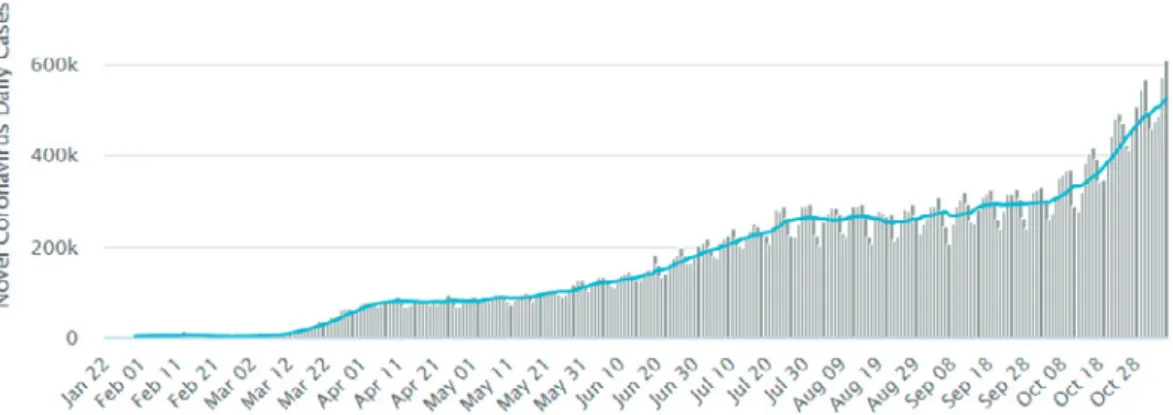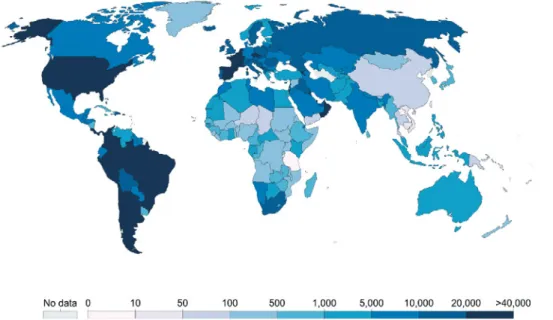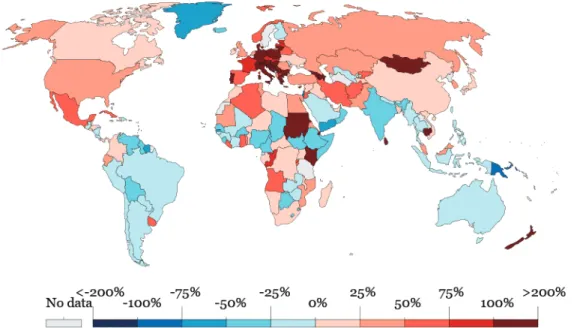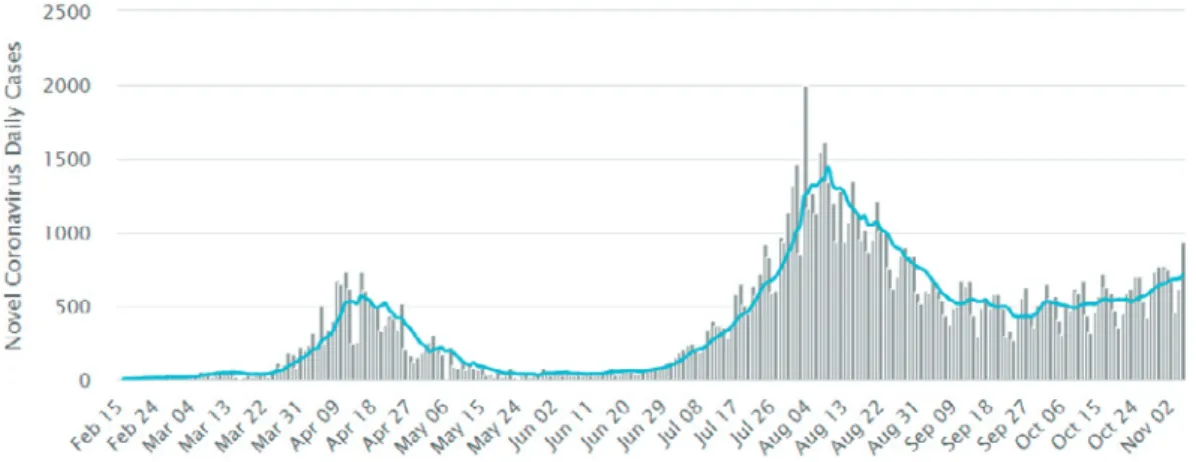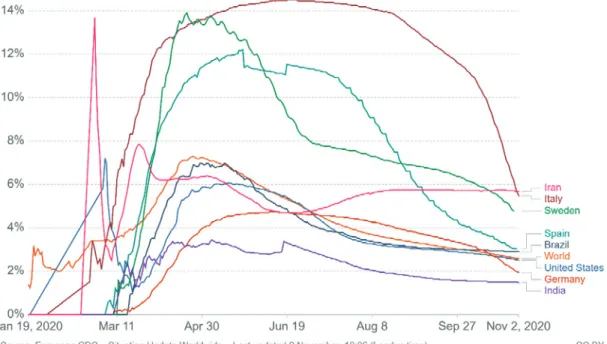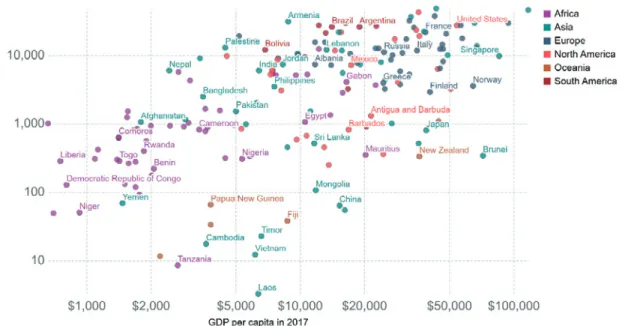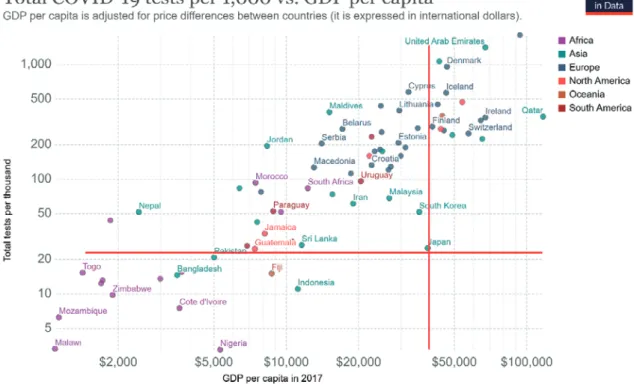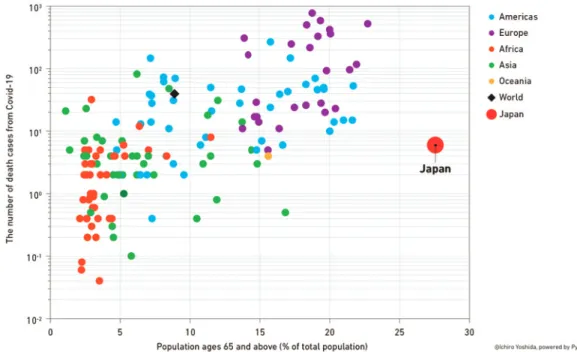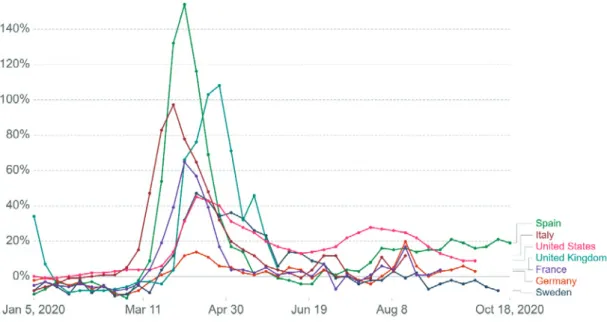総 説 東女医大誌 91(1): 29-39, 2021.2
特集 COVID-19
日本と世界の疫学的視点からの現状と課題
東京女子医科大学医学部国際環境・熱帯医学講座 スギシタ トモヒコ杉下 智彦
(受理 2020 年 11 月 25 日) COVID-19 PandemicEpidemiology and Challenges in Japan and the World
Tomohiko Sugishita
Department of International Affairs and Tropical Medicine, Tokyo Women s Medical University School of Medicine, Tokyo, Japan
The coronavirus disease (COVID-19) pandemic emerged from China in December 2019 and has rapidly spread worldwide. It has led to public health emergencies, which resulted in global catastrophic social changes and eco-nomic restrictions. As of November 2, 2020, the total numbers of COVID-19 infection and death cases were over 46,000,000 and 1,200,000, respectively. However, the number of COVID-19 cases in Japan seems to be minimal compared with that in Europe and the USA. Globally, most infected and death cases occur in high― and high-middle income countries and urban populations. This pandemic is an extraordinary event in the recent history of mankind. The impact of the pandemic has revealed new vulnerabilities in society, including globalization, urbani-zation, non-communicable diseases, and aging. While making efforts to achieve universal health coverage, our fu-ture depends on a lifestyle of a“new normal” with the mindset of the“whole systems approach and planetary consciousness.” In this study, we performed epidemiological analysis and identified new vulnerabilities in our so-ciety, which demand innovation, cooperation, and dialogue.
Keywords: COVID-19, pandemic, epidemiology, case fatality rate, universal health coverage
はじめに
2019 年 12 月に中国の武漢市で発生した新型コロ
ナウイルス感染症(COVID-19)は,経済のグローバ
ル化を反映して,大量輸送時代の中で瞬く間に地球
規模で拡大した.これまでは低・中所得国の課題と
されていた感染症が,医療技術やサービスの最先端
である欧米の高所得国で爆発的な感染拡大(パンデ
ミック)を引き起こし,世界全体の経済・社会活動
を停滞させた.これまでの多くの新興・再興ウイル
ス感染症は,すでに地球上に存在し地域に散発して
いた病原体が感染拡大を起こすパターンが主流で
あった.しかし新型コロナウイルスは,人類がこれ
Corresponding Author: 杉下智彦 〒162―8666 東京都新宿区河田町 8―1 東京女子医科大学医学部国際環境・熱帯医学講 座 sugishita.tomohiko@twmu.ac.jp doi: 10.24488/jtwmu.91.1_29Copyright Ⓒ 2021 Society of Tokyo Women s Medical University. This is an open access article distributed under the terms of Creative Commons Attribution License (CC BY), which permits unrestricted use, distribution, and reproduction in any medium, provided the original source is properly credited.
Figure 1. COVID-19 daily new cases in the world (as reported on November 2, 2020). Adapted from reference 2.
Figure 2. COVID-19 daily deaths cases in the world (as reported on November 2, 2020). Adapted from reference 2.
まで経験したことのない未知のウイルスであり,そ
れゆえに病原性,病態,治療などが全く不明であり,
その不確実性から社会的・経済的・心理的な初動の
遅れや都市封鎖(ロックダウン),医療崩壊を引き起
こし,世界のあらゆる場所における社会の在り方を
大きく変貌させてしまった
1).本稿では,世界および
日本の新型コロナウイルス感染症の疫学から見えて
くる,ウイルスやパンデミックの実像と将来の展望
を考察する.
世界,そして日本における
新型コロナウイルス感染症の疫学
2020 年 11 月 2 日現在,新型コロナウイルス感染
者数は,全世界で 4,600 万人,死亡者数も 120 万人を
超え,まだ第 1 波さえも収束していない状況であり,
死者数も一旦低下したものの再び増加傾向にある
(Figure 1,Figure 2)
2).累積患者数は,米国の感染者
数 960 万人,インド 840 万人,ブラジル 550 万人で,
これら 3 か国で全世界の累積感染者の 51% を占め
ている
3)(Figure 3)
4).ウイルスの DNA 解析から,中
国で発生した新型コロナウイルスは,欧州に渡った
後,特に大西洋の往来によって伝播が起こり北米で
感染が拡大.その後,中南米やインド,ロシアなど
に伝播したと考えられている(Figure 4)
5).経済活動
の再開や世界的伝播により,2020 年 11 月時点で,欧
州,一部のアジアやアフリカで新規感染者数が急増
しており,経済活動を再開した国々でも再び都市封
鎖(ロックダウン)を発動する事態となっている
(Figure 5,Figure 6)
6)7).
日本では,11 月 2 日現在,感染者数 101,813 人,死
者数は 1,774 人であり,欧米諸国と比較すると感染
拡大は抑えられている.しかし感染者が初発した中
国の 9 万人よりも多く,韓国の 2 万 3 千人,ベトナ
ムの 1,200 人であることを考えるとアジア諸国の中
では比較的高いと言える
3).経時的な推移を見ると,
Figure 3. Cumulative confirmed COVID-19 cases per million people (as reported on No-vember 2, 2020).
Adapted from reference 4.
Figure 4. The COVID-19 pandemic dissemination flow by the DNA analysis (as reported on November 2, 2020).
Adapted from reference 5.
死者数の多かった第 1 波を経て,経済活動の再開に
より第 2 波が起こり,その後の努力で収束に向かい
始めている中で,冬の到来とともに,密閉空間やウ
イルスの生存期間の伸長などを原因とする第 3 波が
懸念される状況である(Figure 7,Figure 8)
8).
一般的には感染症による致死率が経時的に低下す
ることが知られている
9).新型コロナウイルス感染症
による致死率は,2020 年 4∼5 月をピークに医療崩
壊を起こした国々で 15%(全年齢平均)程度の高い
致死率となったが,その後は 2∼3% 台と低下して下
げ止まっている(Figure 9)
10).日本における致死率
も 2020 年 6 月をピークに同様の低下傾向を認めて
いるが,日本における季節性のインフルエンザの致
死率は 0.1% 程度であることを考えると,重症肺炎
Figure 5. Daily new confirmed COVID-19 cases per million people (as reported on No-vember 2, 2020).
Adapted from reference 6.
Figure 6. Bi-weekly change in confirmed COVID-19 cases (as reported on November 2, 2020).
Figure 7. COVID-19 daily new cases in Japan (as reported on November 2, 2020). Adapted from reference 8.
Figure 8. COVID-19 daily deaths cases in Japan (as reported on November 2, 2020). Adapted from reference 8.
やサイトカインストーム,血液凝固系異常などを引
き起こす危険なウイルス感染症であり,特に高齢者
や基礎疾患を持つ人たちへの感染拡大に関して細心
の注意を継続する必要がある
11)(Figure 10)
10).
新型コロナウイルス感染症の疫学からわかる
社会の脆弱性
新型コロナウイルス感染症の疫学は,これまでの
感染症とは全く異なる社会の脆弱性を明らかにし
た.従来の感染症拡大は,低中所得国などの貧困や
格差,社会インフラ,医療サービスや保健人材など
の保健システム基盤が脆弱な場所で拡大し,人的・
社会的な被害を大きくしてきた.しかし,新型コロ
ナウイルス感染症では高所得国で感染者数,死者数
が多く,累積死亡数で見ると中高所得・中所得者が
全体の 85% 以上を占めている(Figure 11)
12).また
大陸別の感染者数の推移を見てもアフリカやアジア
での感染拡大は非常に限定的である(Figure 12,
Figure 13)
13)14).ただし,検査数の少なさから過少報
告ではないかと疑問が呈されているが,実際には日
本より低所得の国々でも人口あたりの検査数が多い
国は多数ある(Figure 14)
15).
アフリカ大陸における新型コロナウイルス感染症
による観察致死率は 2.1% と,イタリア(5.8%),世
界平均(3.3%),米国(3.1%)を下回っており,医療
資源が限られているにもかかわらず致死率が低い
(Figure 9)
10).これは平均年齢が低く,生活習慣病が
少ないことに加えて,度重なる新興・再興感染症に
よって社会的免疫が政府や国民にあったこと,感染
拡大の初期からロックダウンを実行し,診断や治療
体制を急速に整えてきたこと,過去に他のコロナウ
イルスに曝露され交差免疫を獲得していた可能性な
どが指摘されている
16).
新型コロナウイルス感染症では高齢者や基礎疾患
のある患者の致死率が低いことが知られているが,
Figure 9. Case fatality rate of the ongoing COVID-19 pandemic. Adapted from reference 10.
Figure 10. Case fatality rate of the ongoing COVID-19 pandemic in Japan. Adapted from reference 10.
日本は世界で最も高齢化が進んだ国であるにもかか
わらず,新型コロナウイルス感染による死亡者は他
の高齢化が進んだ欧米諸国と比べても非常に少な
かったと言える(Figure 15)
17).これは欧米において
急激な感染拡大による高度医療キャパシティの 迫
による医療崩壊が起こったため,若年者の治療が優
Figure 11. Total confirmed COVID-19 deaths by income group (as reported on Novem-ber 2, 2020).
Adapted from reference 12.
Figure 12. Total confirmed COVID-19 deaths by income group (as reported on Novem-ber 2, 2020).
Figure 13. Daily confirmed COVID-19 cases by each continent (as reported on November 2, 2020).
Adapted from reference 14.
Figure 14. Total COVID-19 tests per 1,000 versus GDP per capita (as reported on No-vember 2, 2020).
Figure 15. Association between the total death cases and the aging rate (as reported on May 31, 2020).
Adapted from reference 17.
先され高齢者の治療を断念したことの証左と考えら
れ,日本では医療キャパシティを確保し,高齢者施
設と急性期病院が連携して高齢者へも十分な高度治
療を行っていたと考えられる
18).
本稿の最後は,新型コロナウイルス感染症パンデ
ミックの間接的な健康への影響について見てみる.
国境封鎖や都市封鎖による移動や物流の制限,所得
の減少と失業の増加,社会不安からくる自殺の増加
など,パンデミックの中長期的な影響は甚大であり,
今後は社会・経済的な影響による死亡数の方が感染
による直接的な死亡数よりも上回ると予測されてい
る
19).感染症が流行した一定の期間の死亡数が,過去
の平均的な水準をどれだけ上回っているか示す「超
過死亡」を見ると,米国においては,2020 年 3∼7
月期の超過死亡は例年と比較して全国平均で 67%,
ニ ュ ー ヨ ー ク 州 で は 209% も の 増 加 が 認 め ら れ
た
20).欧米では医療崩壊を示唆するように 2020 年
3∼6
月を中心に超過死亡の激増を認めている(Fig-ure 16)
21).一方で,日本を含む東アジアでは超過死
亡の優位な増加は認められておらず,南アフリカな
どでは 9% の減少となっており,マスクや手洗いの
普及や外出自粛などによるインフルエンザなどの感
染症の減少,交通事故や労災による死亡,殺人など
の減少によって超過死亡が減っている可能性があ
る.しかしケニアなどでは病院受診を控えることに
より,マラリアの検査数の減少や帝王切開率の上昇
などが認められており
22),医療資源の乏しい国々で
は引き続き中長期的な視点に立った対応が重要であ
る.
新型コロナウイルス感染症の疫学から見た
未来の展望
新型コロナウイルス感染症の感染拡大の様式は,
飛沫感染および接触感染を通した人の移動と接触に
よって起こり,主にクラスターと呼ばれる小規模集
団感染によって広がっていった.豪華客船やライブ
ハウス,カラオケ店,風俗店,ジムや介護施設など,
都市部での密集・密接・密閉された空間でのクラス
ター発生が感染を拡大させたように,経済的な効率
性を追求した移動や空間の設計が感染拡大の温床と
なった.一方で,国境や都市封鎖によって大気汚染
が大幅に改善し,インド北部では 200 km 離れたヒ
マラヤ山脈が見晴らせるようになったという報道が
あった
23).新型コロナウイルス感染症パンデミック
がもたらした社会や環境の変化は,
「持続可能な開発
目標(SDGs)」を目指しながらも取り組むことができ
ていなかった健康や環境といった根源的な課題解決
を一気に推し進める壮大な社会実装であると言え
る.
新型コロナウイルス感染症による公衆衛生危機
は,これまでのグローバル社会がいかにパンデミッ
Figure 16. Excess mortality during COVID-19 in the selected countries (as reported on November 2, 2020).
Adapted from reference 21.
Table 1. Conventional and new vulnerabilities in the society.
Conventional vulnerability New vulnerability
Attribution ■ Disparity ■ Globalization
■ Poverty ■ Economic prosperity
■ Rural area ■ Urbanization
■ Healthcare Systems ■ Aging
■ Gender ■ NCDs
■ Nutrition ■ Science and technology
■ Education
Direction Sustainability for human (prosperity) Sustainability for planet (continuity) SDGs Human-centered approach Whole Systems Approach
Economic Prosperity Planet-consciousness
クに脆弱であるかを露呈した.従来の資本主義社会
では,経済活動の主体である「人間」が世界観の中
心にいた.しかし「ウイルスと共存する」社会にお
いては,生態系への無秩序な進出,密集した都市の
設計,経済効率を追求した働き方がパンデミックに
対して脆弱であることがわかった
24).これはまさに
21 世紀の社会が直面する「新しい脆弱性」である
(Table 1).しかし同時に,これまでにないスピード
で科学的なエビデンスに基づきウイルスが解明さ
れ,ワクチンや治療薬の開発が進み,社会学・経済
学・行動学・政治学など医学以外の学際的知見に
よってパンデミックの影響による社会や経済のあら
ゆる側面が知見となって集積されてきている.
解決から共存へ,分断から連帯へ,一人称の「私」
から他者を思いやる複数形の「私たち」へ,新型コ
ロナウイルスによるパンデミックを経た新生活様式
(ニューノーマル)では,時代の羅針盤は大きく方向
を変えようとしている.未来社会の目標や方向性は,
これまでの「人類の発展」を追求する人間中心の発
展的モデルから,持続可能な社会を目指すための分
野を越えた包括的視点(Whole Systems Approach)
や地球全体を意識(Planet Consciousness)の醸成が
非常に重要である.私たちは,21 世紀の社会が直面
する「新しい脆弱性」に対して,パンデミックの発
生を人類の歴史や地球全体のエコロジーの視点から
俯瞰し,地球全体を意識したパラダイムへの変革を
通して,
「ウイルスと共存する」新たな生活様式を実
践する歴史的な転換点に立っている.
開示すべき利益相反状態はない. 文 献1)Lisa Baraitser, Laura Salisbury: Containment, de-lay, mitigation; waiting and care in the time of a pandemic. Wellcome Open Research 5: 129, 2020 2)Worldometer : Coronavirus Worldwide Graphs.
https://www.worldometers.info/coronavirus/ worldwide-graphs/ (Accessed November 2, 2020) 3)https://coronavirus.jhu.edu/map.html ( Accessed
November 2, 2020)
4)Our World in Data: Cumulative confirmed COVID-19 cases. Map and country time-series. https:// ourworldindata.org/grapher/covid-daily-vs-total-cases-per-million (Accessed November 2, 2020) 5)Nextstrain team : Genomic epidemiology of
novel coronavirus-Global subsampling. https:// nextstrain.org/ncov/global (Accessed November 2, 2020)
6)Our World in Data: Daily new comfirmed COVID-19 cases per million people. https://ourworldindata. org/grapher/covid-daily-vs-total-cases-per-million (Accessed November 2, 2020)
7)Our World in Data: Biweekly change in confirmed COVID-19 cases. https://ourworldindata.org/ grapher/covid-daily-vs-total-cases-per-million ( Ac-cessed November 2, 2020)
8)Worldometer : https://www.worldometers.info/ coronavirus/country/japan/ (Accessed November 2, 2020)
9)https://bio.nikkeibp.co.jp/atcl/news/p1/20/10/01/ 07452/ (Accessed November 2, 2020)
10)Our World in Data: Statistics and Research. Mortal-ity Risk of COVID-19. Case fatalMortal-ity rate. https:// ourworldindata.org/mortality-risk-covid ( Accessed November 2, 2020)
11)Joost Wiersinga, Andrew Rhodes, Allen Cheng et al: Pathophysiology, Transmission, Diagnosis, and Treatment of Coronavirus Disease 2019 ( COVID-19): A Review. JAMA 324 (8): 782―793, 2020
12)Our World in Data : Total confirmed COVID-19
deaths By Income Group. https://ourworldindata. org/charts (Accessed November 2, 2020)
13)Our World in Data : Total confirmed COVID-19 deaths per million vs GDP per capita. https:// ourworldindata.org/charts (Accessed November 2, 2020)
14)Our World in Data : Daily confirmed COVID-19 cases, Stacked area chart-by world region. https:// ourworldindata.org/charts (Accessed November 2, 2020)
15)Our World in Data: Total COVID-19 tests per 1,000 vs. GDP per capita. https://ourworldindata.org/ charts (Accessed November 2, 2020)
16)The pandemic appears to have spared Africa so far. https://www.sciencemag.org/news/2020/08/ pandemic-appears-have-spared-africa-so-far-scientists-are-struggling-explain-why ( Accessed November 2, 2020)
17)Japan International Cooperation Agency: To Our Friends and Partners Fighting Against COVID-19 in Developing Countries (2020 ). https://www.jica. go.jp/COVID-19/ja/responses/research/adtkbc 0000000ctl-att/full_document.pdf ( Accessed No-vember 2, 2020)
18)アカシアハイツ診療支援報告.https://www.city. sapporo.jp/gikai/html/documents/05_021007_ kennsyou.pdf (Accessed November 2, 2020) 19)Manfred Lenzen, Mengyu Li, Arunima Malik et
al: Global socio-economic losses and environmental gains from the Coronavirus pandemic. PLoS One 15 (7): e0235654, 2020
20)Steven Woolf, Derek Chapman, Roy Sabo et al: Excess Deaths From COVID-19 and Other Causes, March-July 2020. JAMA 324 (15): 1562―1564, 2020 21)Our World in Data : Excess mortality during
COVID-19 : Deaths from all causes compared to previous years, all ages. P-scores. https:// ourworldindata.org/charts (Accessed November 2, 2020)
22)Duncan Shikuku, Irene Nyaoke, Sylvia Gichuru et al: Early indirect impact of COVID-19 pandemic on utilization and outcomes of reproductive, mater-nal, newborn, child and adolescent health services in Kenya, medRxiv. https://doi.org/10.1101/ 2020.09.09.20191247 (Accessed November 2, 2020) 23)People in India can see the Himalayas for the first
time in decades, as the lockdown eases air pollu-tion. https://edition.cnn.com/travel/article/ himalayas-visible-lockdown-india-scli-intl/index. html (Accessed November 2, 2020)
24)Horton R: Offline : COVID-19 ― a crisis of power. Lancet 396: 1383, 2020
